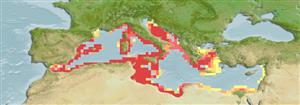Holothuroidea |
Holothuriida |
Holothuriidae
Environment: milieu / climate zone / depth range / distribution range
Ecology
Benthic; depth range 0 - 250 m (Ref. 85345). Subtropical
Atlantic and the Mediterranean Sea: Algeria.
Length at first maturity / Size / Weight / Age
Maturity: Lm ? range ? - ? cm Max length : 20.0 cm TL male/unsexed; (Ref. 358)
Maximum size: 20 cm. Body: with more or less round cross section; is provided with the ventral face with 3 lines with podia with suction cups. Tegument: constellated with multiple papillae. Color: supported black; papillae being very of an immaculate white. Absence of tubes of Vat (Ref. 358).
Maximum size: 20 cm. Species presents the small funds until largest the depths, but rare. Habitat: Hard funds and herbaria. Biology: this species is nourished, using its tentacles oral flattened, of various organic fragments. It (charges) literally elements of the ground in its oral opening, located at the back of the body. The animal sorts the edible organic substances, and rejects the elements not metabolized such as sand, in the form of roved excrements (Ref. 358).
Life cycle and mating behavior
Maturity | Reproduction | Spawning | Eggs | Fecundity | Larvae
Members of the class Holothuroidea are gonochoric and have only one gonad. Spawning and fertilization are both external and some exhibit brooding. Life cycle: Embryos develop into planktotrophic larvae (auricularia) then into doliolaria (barrel-shaped stage) which later metamorphose into juvenile sea cucumbers.
Göthel, H. 1992 Guide de la faune sous-marine: La Méditerranée. Invertébrés marins et poissons. Eygen Ulmer GmbH & Co. 318 p. (Ref. 358)
IUCN Red List Status
(Ref. 130435: Version 2025-1)
CITES status (Ref. 108899)
Not Evaluated
Not Evaluated
Threat to humans
Human uses
| FishSource |
Tools
More information
Trophic EcologyFood items (preys)Diet compositionFood consumptionPredators Life cycleReproductionMaturityFecunditySpawningEggsEgg developmentLarvae PhysiologyOxygen consumption
Human RelatedStamps, coins, misc.
Internet sources
Estimates based on models
Preferred temperature
(Ref.
115969): 13.3 - 18.4, mean 14.9 (based on 106 cells).
Resilience
High, minimum population doubling time less than 15 months (K=0.69).
Fishing Vulnerability
Low vulnerability (17 of 100).
Price category
Unknown.
